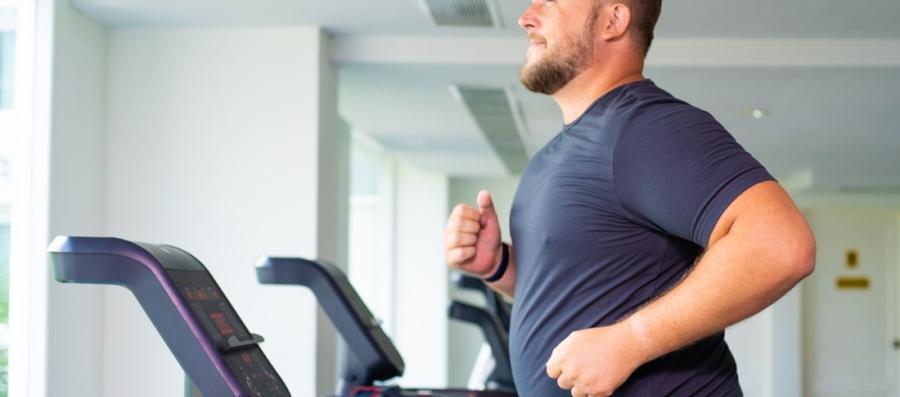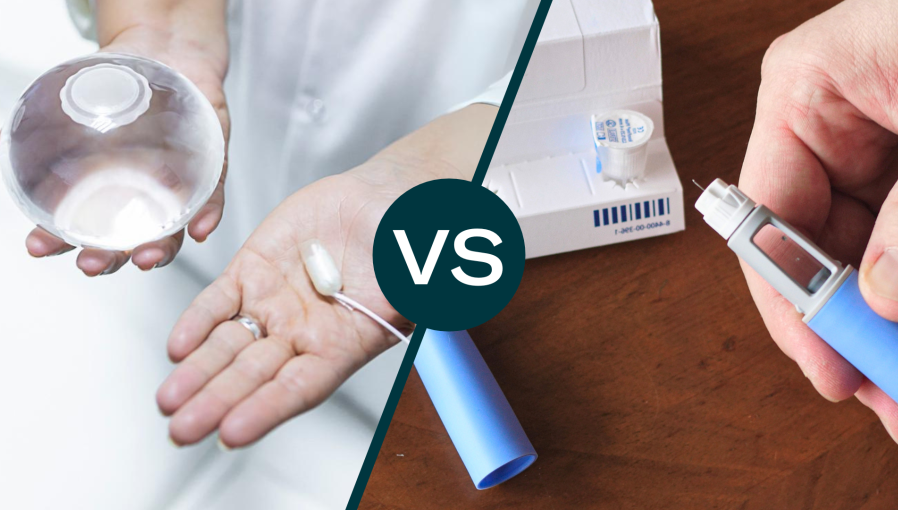Weight Loss for Men: A Science-based Guide to Improving your Health

When we talk about weight loss, it’s easy to resort to stereotypes and assume that it’s mostly women who want to lose weight. But that couldn’t be further from the truth.
Men want to shed excess kilos for all sorts of reasons. Maybe you’re looking to boost your energy levels, curb everyday aches and pains, or reduce the risk of diabetes and cardiovascular disease. Perhaps you want to get a better night’s sleep or improve your mood. Some people want to lose weight so they can fit into their favourite pair of jeans again or to feel more comfortable at the beach or in the gym. Others just want to get more enjoyment and fun out of every day.
No matter what your reason is, you’re certainly not alone.
According to the research by the World Obesity Federation, it’s estimated that 1 in 7 men will be living with obesity – that’s a BMI of more than 30 – by 2030.1 In fact, in some countries – including Japan, South Korea, China, Germany, France, the UK and the US – the prevalence of obesity is much higher for men than for women.2
The impact of excess weight on men’s health
Obesity is linked to a range of health conditions in both men and women, including an increased risk of cardiovascular disease and type 2 diabetes.3 In addition, obesity may also play a role in the development or management of several conditions that specifically affect men. These include:
- benign prostate hyperplasia (or an enlarged prostate gland)
- erectile dysfunction
- hypogonadism (when your body doesn’t produce enough testosterone and/or sperm)
- male infertility
- prostate cancer
The link between men, weight and infertility
It’s estimated that infertility affects as many as 186 million people worldwide. In Western countries alone, it’s thought that 15-25% of couples cannot conceive, or become pregnant, after 12 months of trying.
Male infertility contributes to more than half of all cases of global childlessness.4,5 In men, obesity may lead to an increased risk of infertility.6 In men, overweight and obesity is associated with lower pregnancy rates, but more research is needed in this area, including into the impact of weight loss.7

The link between men, weight and prostate cancer
New insights from a comprehensive study reveal a significant connection between weight-linked body fat and risk of fatal prostate cancer. This extensive analysis, involving over 2.5 million men from 20 studies, found that every 10 cm (3.9 inches) on a man’s waist increased his odds of dying from prostate cancer by 7 per cent. The findings applied to belly fat as well as to overall body fatness.8
Prostate cancer is the most common cancer in men and the second most common cause of cancer death in males. While certain risk factors like age, family history, and ethnicity are beyond our control, identifying weight as a modifiable risk factor could be crucial in reducing the risk.8
The results align with several previous studies that linked a higher amount of body fat to fatal prostate cancer, with central adiposity (fat around the belly and waist) appearing to be particularly important.8 Higher amounts of body fat (adiposity) were linked to higher likelihood of fatal prostate cancer. Every five-point increase in BMI was found to increase the risk of dying from prostate cancer by 10 per cent, while a 5 per cent increase in total body fat percentage raised the risk by 3 per cent.8
The authors concluded that men with higher total and central adiposity have a higher risk of dying from prostate cancer than men with a healthy weight.8
While the mechanisms behind the link were unclear, it’s possible that prostate cancer is more difficult to detect in men with obesity, leading to it later diagnoses when the cancer is harder to treat.8
The study provides yet another reason to encourage men to maintain a healthy weight.
In addition, weight loss can help improve erectile function, hypogonadism and infertility in men living with obesity. It can also help manage urinary tract symptoms that can result from benign prostatic hyperplasia.9,10
Even so, some men are reluctant to ask for help to lose weight. This may be due to a lack of basic nutritional knowledge or simply that men have traditionally been less concerned about their weight or appearance than women.11-13 Often weight-management programs are biased towards the needs of women.14 However, at Allurion, we are committed to providing inclusive and personalized solutions for everyone, recognizing the unique challenges and goals that men face on their weight loss journey.

Effective weight loss for men with the Allurion Programme
So, where to start? For men of all ages, the scientific evidence is overwhelming: the best way to lose weight is through a combination of reduced calorie intake, physical activity advice and support, and the introduction of long-term behaviour change techniques.17
As with women, a good weight-loss program should be personalised and tailored to your weight-loss goals and to your lifestyle.
How the Allurion Programme works
The highly customisable Allurion Programme is a proven and effective method for healthy and sustainable weight loss. It combines the use of the Allurion Balloon —a temporary gastric balloon— with a 6- to 18-month behavioural change program. This comprehensive approach addresses both physical and psychological aspects of weight management, ensuring long-term success.

The Allurion Balloon is an innovation in weight-loss science that’s been developed to help control your appetite, portion sizes and combat the frustration of ‘never feeling full’. Recommended by doctors, it helps you feel fuller faster and stay fuller for longer, so you consume fewer calories while feeling satisfied.
It is placed quickly and easily at an Allurion partner clinic during a simple 15-minute visit – there is no need for surgery, endoscopy, or anaesthesia.
Alongside the Allurion Balloon, the Allurion Programme includes:
- Medical expertise and support from the clinic team, from the first consultation to balloon placement and all throughout the entire programme
- Personalised guidance from your nutritionist, including nutrition coaching, activity and behaviour change guidance and strategies that work for your lifestyle, plus ongoing tracking and support
- A suite of digital tracking tools such as the Allurion Connected Scale, the Health Tracker and the Allurion App, allowing your care team and you to share the same information, track your progress together and make adjustments when needed.
Read more about the holistic approach of the Allurion Programme here.
Results from the Allurion Programme have been proven by numerous clinical studies. Patients lose on average 10-15% of their total body weight in approximately 16 weeks, and 96% of the weight loss, on average, can be maintained even one year after the balloon passes out of the body.18

Customising weight loss for men: understanding the unique considerations
The impressive results achieved with the Allurion Programme highlight the importance of personalisation in an effective weight loss programme, particularly when it comes to nutrition. While broad patterns of healthy eating apply to both men and women, understanding the subtle differences in dietary needs is crucial for men on a weight-loss programme.
For example, men tend to need more calories than women to fuel an average day. The US Department of Agriculture’s Dietary Guidelines for Americans outlines different daily nutritional goals for men and women.15
Macronutrient levels, including for protein and fibre, are elevated for men, as are minerals including magnesium. Women, on the other hand, require higher daily levels of calcium and magnesium. Recommended daily intake of some vitamins also varies according to gender.
It’s a similar story when it comes to hydration – men generally need more fluids than women each day.16 This is especially important to know if you’re increasing your daily activity levels as part of your weight-loss plan.

When you join the Allurion Programme, your nutritionist will work with you to create a personalised plan that addresses your specific nutritional needs while maximizing your weight-loss goals. This will ensure you get all the nutrients, vitamins and minerals you need for optimal function and performance.
An active lifestyle: a key pillar of weight loss success
Being active is a vital element of your journey towards long-term weight loss success. Our programme emphasizes the importance of incorporating regular physical activity into your lifestyle, as it plays a significant role in accelerating your weight loss progress.

Engaging in exercise not only helps you shed pounds more effectively but also offers a myriad of additional benefits. By staying active, you can reduce stress levels, improve the quality of your sleep, and boost your mood, ultimately contributing to an overall sense of well-being.
Read more about exercising with the Allurion Balloon here.
When you join the Allurion Programme, your clinic team will work with you on an exercise plan that aligns with your preferences and weight loss goals.

Now, we know that not everyone relishes the idea of daily jogging, organised sport or cardio sessions in the gym, and that's perfectly understandable. Busy lifestyles often make it difficult to dedicate time to an extensive exercise routine. The good news is that making small tweaks in your lifestyle can make a significant difference in burning calories and helping you reach your weight-loss goals.
Some ideas to get you going:
- Take the stairs instead of hitting the elevator button.
- Hop off the bus or metro one to two stops earlier and walk the rest of the way to work or home.
- Give the garden or garage that makeover you’ve been promising.
- Leave the car at home and cycle to work or to see friends. If you’ve got kids, do the school run by bike.
- Make a furry friend part of your life and meet other dog owners for regular walks.
- Take up yoga or Pilates. Join a dance class, or just turn up the stereo and do your thing at home.
Ready to kickstart your weight loss journey into high gear?
Book a free gastric balloon consultation today!
Before booking, be sure to check your eligibility using our BMI calculator.
Related articles:
- https://www.allurion.com/en/blog/allurion-program-more-effective-dieting-alone https://www.allurion.com/en/blog/how-allurion-programme-can-help-diabetes https://www.allurion.com/en/blog/how-improve-your-heart-health-through-weight-loss-and-nutrition
References
- World Obesity Atlas 2022. World Obesity Federation. https://www.worldobesity.org/resources/resource-library/world-obesity-atlas-2022. Accessed December 14, 2022. Kim KB, Shin YA. Males with Obesity and Overweight. J Obes Metab Syndr. 2020 Mar 30;29(1):18-25. doi: 10.7570/jomes20008. PMID: 32146733; PMCID: PMC7117999. Prospective Studies Collaboration, et al. Body-mass index and cause-specific mortality in 900 000 adults: collaborative analyses of 57 prospective studies. Lancet 2009;373(9669):1083–96. Gaskins AJ, Chavarro JE. Diet and fertility: a review. Am J Obstet Gynecol. 2018;218(4):379-389. doi:10.1016/j.ajog.2017.08.010. Inhorn MC, Patrizio P. Infertility around the globe: new thinking on gender, reproductive technologies and global movements in the 21st century. Hum Reprod Update. 2015;21(4):411-426. doi:10.1093/humupd/dmv016. Cena H, Chiovato L, Nappi RE. Obesity, Polycystic Ovary Syndrome, and Infertility: A New Avenue for GLP-1 Receptor Agonists. J Clin Endocrinol Metab. 2020;105(8):e2695-e2709. doi:10.1210/clinem/dgaa285. PEN, men’s health knowledge pathway, accessed August 2021. Perez-Cornago, A., Dunneram, Y., Watts, E.L. et al. Adiposity and risk of prostate cancer death: a prospective analysis in UK Biobank and meta-analysis of published studies. BMC Med 20, 143 (2022). https://doi.org/10.1186/s12916-022-02336-x. Infertility. World Health Organization. https://www.who.int/news-room/fact-sheets/detail/infertility. Published 2022. Accessed July 21, 2022. Ahmet Tevfik Albayrak, Ege Can Serefoglu, Chapter 2.3 - Obesity and Men's Health, Editor(s): Faysal A. Yafi, Natalie R. Yafi, Effects of Lifestyle on Men's Health, Academic Press, 2019, Pages 149-168, https://doi.org/10.1016/B978-0-12-816665-9.00007-X Lozano-Sufrategui L, Pringle A, Carless D, Drew K. A qualitative study of men’s behavioural changes during weight loss maintenance. Perspectives in Public Health. 2020;140(6):317-326. doi:10.1177/1757913920964516. Stibbe A. Health and the social construction of masculinity in Men’s Health magazine. Men Masc 2004;7:31-51. Gough B, Conner MT. Barriers to healthy eating amongst men: a qualitative analysis. Soc Sci Med 2006;62:387-95. Lozano-Sufrategui L, Pringle A, Carless D, Drew K. A qualitative study of men’s behavioural changes during weight loss maintenance. Perspectives in Public Health. 2020;140(6):317-326. doi:10.1177/1757913920964516. Current dietary guidelines. Dietary Guidelines for Americans, 2020-2025 and Online Materials | Dietary Guidelines for Americans.https://www.dietaryguidelines.gov/resources/2020-2025-dietary-guidelines-online-materials. Accessed December 14, 2022. Institute of Medicine Panel on Dietary Reference Intakes for Electrolytes and Water. Dietary Reference Intakes for Water, Potassium, Sodium, Chloride, and Sulfate. Washington DC: National Academy Press; 2005 https://doi.org/10.17226/10925. Robertson C, Archibald D, Avenell A, et al. Systematic reviews of and integrated report on the quantitative, qualitative and economic evidence base for the management of obesity in men. Southampton (UK): NIHR Journals Library; 2014 May. (Health Technology Assessment, No. 18.35.) Available from: https://www.ncbi.nlm.nih.gov/books/NBK262145/ doi: 10.3310/hta18350 Ienca R, Oyola C, Jarallah M, et al. The Swallowable Gastric Balloon Program: Global experience in 3,716 patients. (2022), Oral Abstracts. Obesity, 30: 54. https://doi.org/10.1002/oby.23625



